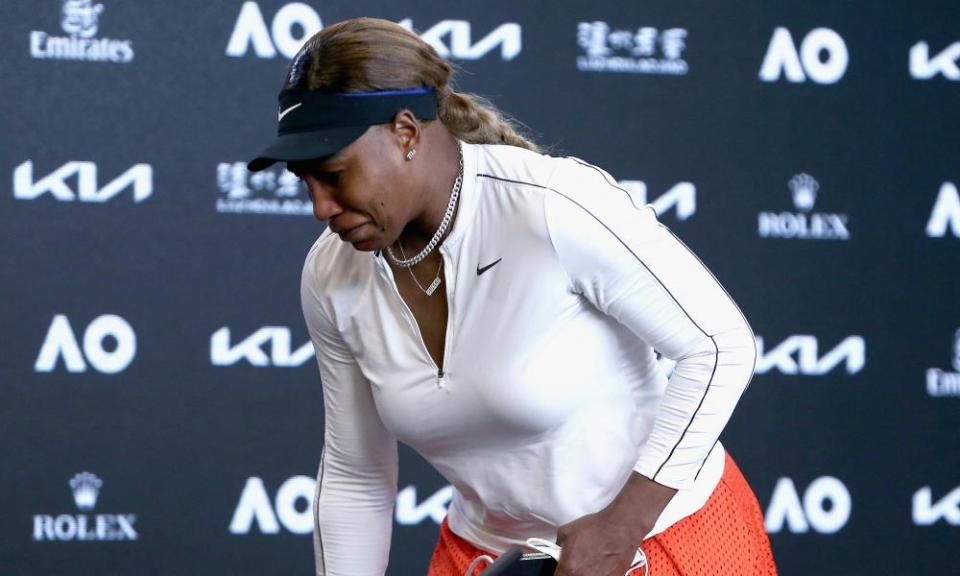What next for Serena Williams after her tearful Australian Open exit?

A few hours after Serena Williams walked out of Rod Laver Arena, beaten in the late stages of a grand slam tournament once more, the Eurosport team had converged in front of the cameras to discuss the day’s play. There stood Barbara Schett, last active 15 years ago, who played against Williams three times, and via video link, Williams’s former rival Justine Henin, who retired in Melbourne 10 years ago. Henin is a year younger than Williams, now a mother of two, and when she was asked if she saw herself competing like Williams again, her response was simple: “No way, no chance.”
Related: Naomi Osaka into Australian Open final as Serena Williams makes tearful exit
While Williams competes against players such as Naomi Osaka, it is easy to forget that her real contemporaries are women such as Schett and Henin. They are almost all long retired, living full lives, enjoying the fruits of their on-court labour in peace. Meanwhile, Williams has just competed in her 77th grand slam tournament, which puts her second on the all-time list to her sister, Venus, who played in her 88th last week.
Such longevity is clearly no consolation for Williams. The last image of her at the tournament was of her abruptly leaving her press conference in tears. There are already discussions of her future, about the precise meaning of her wave as she left the court, but she is allowed, also, just to be frustrated at how things continue to pan out. Since returning from pregnancy she has constantly put herself in a position to win. When her performances in four grand slam finals were not enough, she went away and worked harder.
Over the past month in Australia Williams has been moving better than at any point in the past four years. While opponents such as Simona Halep immediately pointed out the difference between then and now, she was also clearly happy and hopeful about her progress. Asked before her semi-final when she last moved as well as she is, she responded: “It’s definitely been a minute. It’s been a long minute,” she said. “I think 19 ... 1926, the summer of 1926 I think was the last time I felt that.”

Yet none of it worked. Williams’s biggest problem isn’t her game, but how she has come to lose the killer instinct that defined her for so long. Consider some of her feats on Rod Laver Arena alone: in 2003, she recovered from 2-5 down against Kim Clijsters to win her Serena Slam. In the 2005 semi-final she saved three match points in the semi-final to beat Maria Sharapova. Two years later she won the whole thing while ranked 81st. In 2017 she was pregnant and easily fatigued, so she conserved energy by beating everyone in straight sets.
By 2015 Williams’s record in grand slam finals was 21-4. She was the great closer. Her ability to excel in the toughest moments was so common that it was easy for people to forget how difficult just winning even one title is. Now we know. Since Williams fell to Roberta Vinci at the 2015 US Open as she chased the grand slam, her major final record is 2-6, and she has lost in more semi-finals (4) since then than in the rest of her career.
Related: Jennifer Brady defies lockdown and Muchová to reach Australian Open final
She has reached the part of her career where experience can be detrimental. She knows too much: she understands exactly what it means to win a grand slam title, that this will all soon be over and that every failure is a wasted opportunity. Winning is so difficult under these circumstances.
Meanwhile, Osaka represents some of the freedom and fortitude that she has lost. First she refused to make a single unforced error in the final 22 points of her fourth-round comeback to Garbiñe Muguruza from a 3-5 15-40 deficit, then she responded to losing serve with three double faults for 6-3 4-4 against Williams by winning the final eight points and the match. Now she is chasing a 4-0 record in grand slam finals.
It remains to be seen if Williams will be able to play freely enough to even contend for her 24th grand slam title. Whether or not she does, instead of a failure, this period is rather context for what it really took to achieve all that she has.

 Yahoo Sport
Yahoo Sport 





































